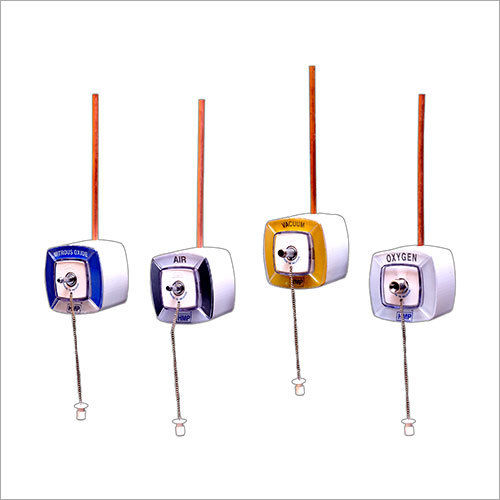The Medical gas Outlet with Probe is parked in the slot and gas specific probe gets locked in fascia to draw the gas supply, the probe is depressed to lock into mechanism and gas starts flowing for stopping the flow of side of the unit. The releases the probe instantly from its locking arrangement, there by disengaging the gas flow.
Feature - Single lock type
- High flow rate against minimum pressure drops
- Accurate performance
- Simple design
- Easy installation
Robust Construction and Superior SafetyMade from precision-machined brass or stainless steel, these gas outlets are designed for enduring performance in demanding environments. Non-interchangeable indexing prevents misconnections, while integrated backflow prevention boosts operational safety. The rugged construction supports a typical service life of over 10 years with routine maintenance.
Versatile Mounting and Wide CompatibilityThese outlets are engineered for surface or concealed mounting on walls, bed head panels, or pendants. With outlet connections available in DISS, Ohmeda, Chemetron, British, and French standards, installation is simplified across diverse medical and laboratory settings, ensuring a reliable fit and easy upgrades to existing systems.
Effortless Identification and MaintenanceFeaturing clear color-coded identification and a leak-proof design, these outlets enable quick and confident gas source recognition. Installation accessories, dust caps, and retaining clips are supplied for efficient setup and ongoing maintenance, while each unit is individually boxed with comprehensive user instructions.
FAQs of Gas Outlets:
Q: How are these gas outlets installed in medical and laboratory settings?
A: Our gas outlets can be installed using surface or concealed mounting, compatible with wall, bed head panel, or pendant fixtures. Each package includes installation screws, dust caps, and retaining clips, ensuring a secure and straightforward set-up process.
Q: What types of gases can be used with these outlets and in which environments are they suitable?
A: These gas outlets are designed for various medical and laboratory gases including oxygen, nitrous oxide, medical air, vacuum, and carbon dioxide. They are ideally suited for use in hospitals, clinics, research facilities, and laboratories.
Q: When should routine maintenance be performed on these gas outlets?
A: Routine maintenance is recommended according to facility protocols, but generally, inspecting the outlet functionality, seals, and connections every 6-12 months helps ensure optimal performance and extends service life, typically over 10 years with proper care.
Q: What standards and safety features do these outlets comply with?
A: Our gas outlets strictly adhere to ISO 9170-1, HTM 02-01, NFPA, and DIN 13260 standards. Safety features include non-interchangeable indexing to prevent misconnections, robust backflow prevention mechanisms, and leak-proof construction.
Q: Where can these gas outlets be used and are they available in different connection types?
A: These outlets are suitable for installation in a wide range of healthcare and research environments. They are available with DISS, Ohmeda, Chemetron, British, and French connection options to ensure adaptability and compliance with global standards.
Q: What is the installation process and what accessories are included?
A: Installation involves mounting the outlet securely and connecting it to the gas pipeline using industry-standard fittings. Each outlet comes with an individual protective box, user instructions, dust caps, retaining clips, and necessary installation hardware.
Q: What benefits do these gas outlets provide to healthcare and research facilities?
A: Key benefits include color-coded identification for safety, reliable leak-proof operation, easy and secure connections, long service life, and adherence to global norms. These features collectively enhance operational efficiency and reduce maintenance downtime in critical environments.
